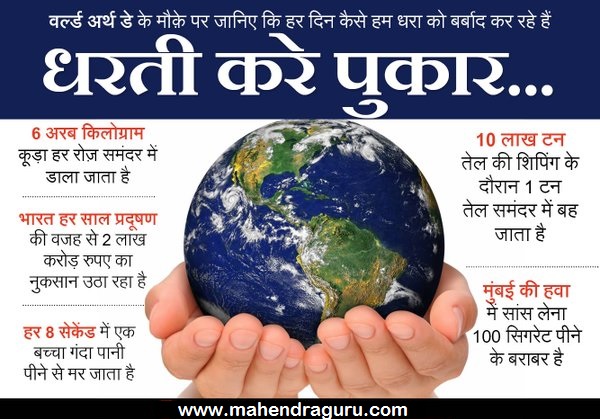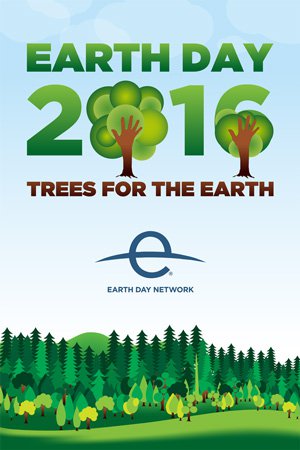Celebrated every year on April 22, Earth Day aims to encourage people across the world to be more environmentally friendly.
This might mean increasing the amount they recycle, volunteering for a local green project or installing solar panels at their home.
The very first event for Earth Day, which was held in America nearly five decades ago following a devastating oil spill, is credited as the beginning of the modern environmental movement.

Since its launch, Earth Day has been supported by an array of famous faces, including Hollywood stars Leonardo DiCaprio and Emma Watson.
Now it is coordinated globally by the non-profit Earth Day Network, which describes it as ‘the largest secular holiday in the world’.
Each year, festivals, parades and rallies are held in at least 192 countries to demonstrate support for environmental protection.
The day has its own flag, which was created by US peace activist John McConnell and, perhaps unsurprisingly, features a picture of the world on it.
It also has its own anthems – one of which is performed to the tune of Beethoven’s Ode To Joy, but with lyrics about protecting the planet.
This year, more than one billion people are expected to celebrate Earth Day.
Earth Day 2016 — Trees for the Earth.
Over the next five years, as Earth Day moves closer to its 50th anniversary, we’re calling on you to help us achieve one of our most ambitious goals yet —we’re planting 7.8 billion trees and we’re starting now.
Trees will be the first of five major goals we are undertaking in honor of the five-year countdown to our 50th anniversary. On their own and together, these initiatives will make a significant and measurable impact on the Earth and will serve as the foundation of a cleaner, healthier and more sustainable planet for all.

Why Trees?
Trees help combat climate change.
They absorb excess and harmful CO2 from our atmosphere. In fact, in a single year, an acre of mature trees absorbs the same amount of CO2 produced by driving the average car 26,000 miles.
Trees help us breathe clean air.
Trees absorb odors and pollutant gases (nitrogen oxides, ammonia, sulfur dioxide and ozone) and filter particulates out of the air by trapping them on their leaves and bark.
Trees help communities.
Trees help communities achieve long-term economic and environmental sustainability and provide food, energy and income.
Plant a tree. Make a donation. Activate your friends and social networks.
Where is Earth Day celebrated?
All across the Earth, of course!
The first Earth Day was held on April 22, 1970, in America.
It was founded by former US senator Gaylord Nelson after he saw the enormous 1969 oil spill in Santa Barbara, California.
To mark the landmark occasion, a staggering 20million people took part in rallies across the US.
In 1990, the event went global, with 200million people in 141 countries celebrating it, according to the Earth Day Network.
More than two decades on, at least 192 countries mark Earth Day every year, including Britain, Canada, Ukraine, Spain, and the Philippines.
Some communities even celebrate Earth Week – an entire seven days of activities and rallies focused on the world’s environmental problems.
How should I celebrate?
Here are six ways to mark Earth Day:
· Grow your own food (or buy locally-grown produce)
· Go paperless
· Plant a tree
· Stop drinking bottled water
· Start carpooling (or take up cycling)
· Invest in a solar-powered phone charger
The Idea
The idea for a national day to focus on the environment came to Earth Day founder Gaylord Nelson, then a U.S. Senator from Wisconsin, after witnessing the ravages of the 1969 massive oil spill in Santa Barbara, California. Inspired by the student anti-war movement, he realized that if he could infuse that energy with an emerging public consciousness about air and water pollution, it would force environmental protection onto the national political agenda. Senator Nelson announced the idea for a “national teach-in on the environment” to the national media; persuaded Pete McCloskey, a conservation-minded Republican Congressman, to serve as his co-chair; and recruited Denis Hayes from Harvard as national coordinator. Hayes built a national staff of 85 to promote events across the land. April 22, falling between Spring Break and Final Exams, was selected as the date.
On April 22,1970, 20 million Americans took to the streets, parks, and auditoriums to demonstrate for a healthy, sustainable environment in massive coast-to-coast rallies. Thousands of colleges and universities organized protests against the deterioration of the environment. Groups that had been fighting against oil spills, polluting factories and power plants, raw sewage, toxic dumps, pesticides, freeways, the loss of wilderness, and the extinction of wildlife suddenly realized they shared common values.
Earth Day 1970 achieved a rare political alignment, enlisting support from Republicans and Democrats, rich and poor, city slickers and farmers, tycoons and labor leaders. By the end of that year, the first Earth Day had led to the creation of the United States Environmental Protection Agency and the passage of the Clean Air, Clean Water, and Endangered Species Acts. “It was a gamble,” Gaylord recalled, “but it worked.”
What is the Paris Agreement?
On April 22, at least 130 countries are set to sign the Paris Agreement on climate change.
The historic agreement, which was adopted by consensus in the French capital in December, will be deposited at the United Nations in New York in a bid to get other countries to sign up to it.
It will be open for signature for one year from Earth Day.
According to the European Commission, the agreement ‘sets out a global action plan to put the world on track to avoid dangerous climate change by limiting global warming to well below 2C’.
It is scheduled to come into force in 2020.
After the deal was adopted in Paris on December 12, 2015, former deputy prime minister John Prescott referred to it as ‘an historic moment for our planet’.
Both China and the United States - the world’s top carbon dioxide emitters – have promised to sign the agreement at the upcoming UN ceremony on Earth Day.
French President Francois Hollande is also due to sign it.
However, signing is only one step in a tortuous UN process for the deal to come into force.
The process requires formal approval by at least 55 nations representing 55 per cent of man-made greenhouse gas emissions.
In many countries, that needs a parliamentary vote.




